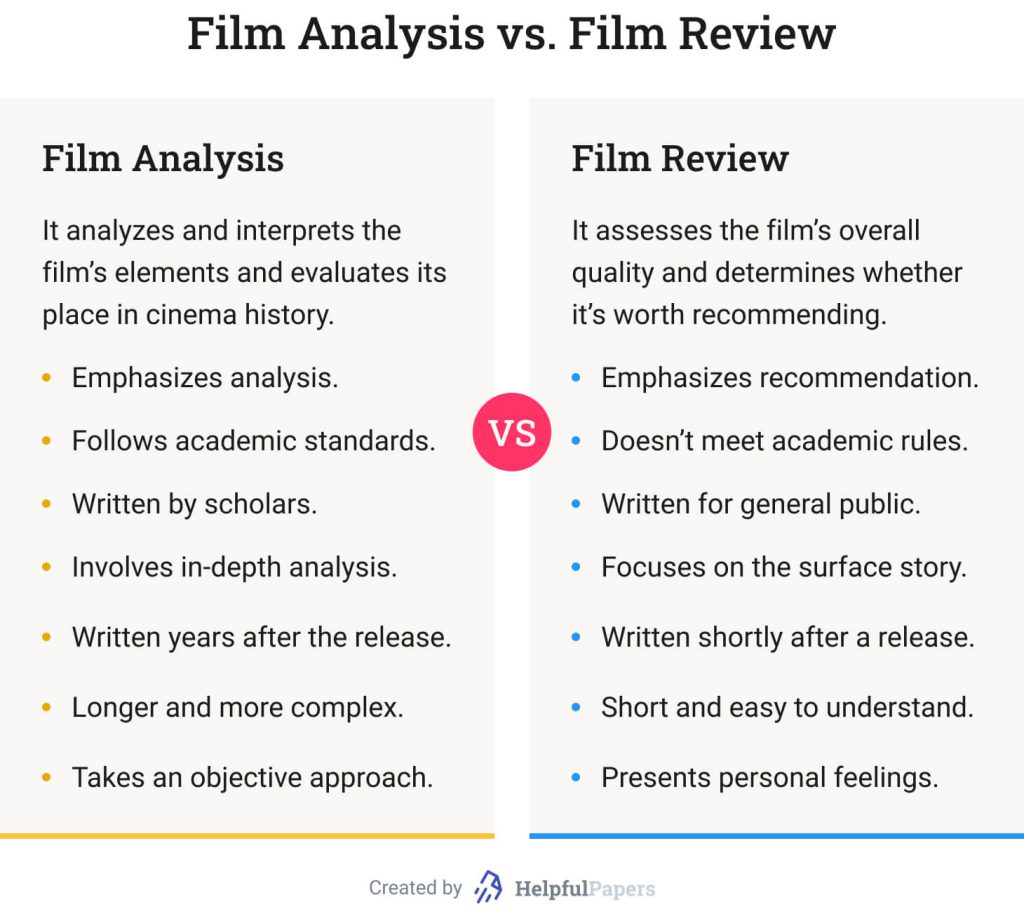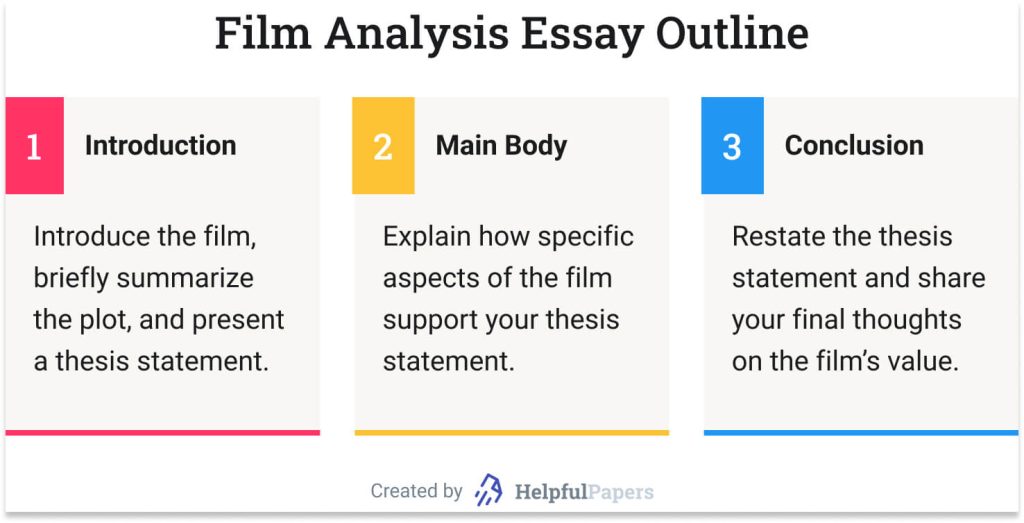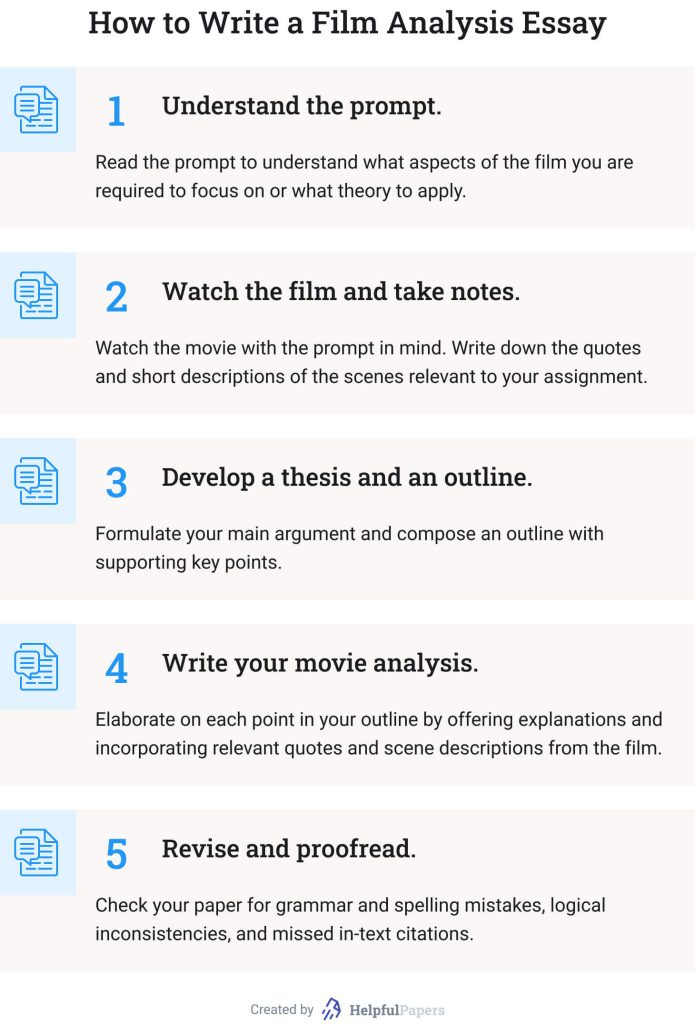Films are never just films. Instead, they are influential works of art that can evoke a wide range of emotions, spark meaningful conversations, and provide insightful commentary on society and culture. As a student, you may be tasked with writing a film analysis essay, which requires you to delve deeper into the characters and themes. But where do you start?
In this article, our expert team has explored strategies for writing a successful film analysis essay. From prompts for this assignment to an excellent movie analysis example, we’ll provide you with everything you need to craft an insightful film analysis paper.
📽️ What Is a Film Analysis Essay?
A film analysis essay is a type of academic writing that critically examines a film, its themes, characters, and techniques used by the filmmaker. This essay aims to analyze the film’s meaning, message, and artistic elements and explain its cultural, social, and historical significance. It typically requires a writer to pay closer attention to aspects such as cinematography, editing, sound, and narrative structure.
Film Analysis vs Film Review
It’s common to confuse a film analysis with a film review, though these are two different types of writing. A film analysis paper focuses on the film’s narrative, sound, editing, and other elements. This essay aims to explore the film’s themes, symbolism, and underlying messages and to provide an in-depth interpretation of the film.
On the other hand, a film review is a brief evaluation of a film that provides the writer’s overall opinion of the movie. It includes the story’s short summary, a description of the acting, direction, and technical aspects, and a recommendation on whether or not the movie is worth watching.

📚 Types of Film Analysis
Wondering what you should focus on when writing a movie analysis essay? Here are four main types of film analysis. Check them out!
📋 Film Analysis Format
The movie analysis format follows a typical essay structure, including a title, introduction, thesis statement, body, conclusion, and references.
The most common citation styles used for a film analysis are MLA and Chicago. However, we recommend you consult with your professor for specific guidelines. Remember to cite all dialogue and scene descriptions from the movie to support the analysis. The reference list should include the analyzed film and any external sources mentioned in the essay.
When referring to a specific movie in your paper, you should italicize the film’s name and use the title case. Don’t enclose the title of the movie in quotation marks.
📑 Film Analysis Essay Outline
A compelling film analysis outline is crucial as it helps make the writing process more focused and the content more insightful for the readers. Below, you’ll find the description of the main parts of the movie analysis essay.

Film Analysis Introduction
Many students experience writer’s block because they don’t know how to write an introduction for a film analysis. The truth is that the opening paragraph for a film analysis paper is similar to any other academic essay:
- Start with a hook to grab the reader’s attention. For example, it can be a fascinating fact or a thought-provoking question related to the film.
- Provide background information about the movie. Introduce the film, including its title, director, and release date. Follow this with a brief summary of the film’s plot and main themes.
- End the introduction with an analytical thesis statement. Present the central argument or interpretation that will be explored in the analysis.
Film Analysis Thesis
If you wonder how to write a thesis for a film analysis, we’ve got you! A thesis statement should clearly present your main idea related to the film and provide a roadmap for the rest of the essay. Your thesis should be specific, concise, and focused. In addition, it should be debatable so that others can present a contrasting point of view. Also, make sure it is supported with evidence from the film.
Let’s come up with a film analysis thesis example:
Through a feminist lens, Titanic is a story about Rose’s rebellion against traditional gender roles, showcasing her attempts to assert her autonomy and refusal to conform to societal expectations prevalent in the early 20th century.
Movie Analysis Main Body
Each body paragraph should focus on a specific aspect of the film that supports your main idea. These aspects include themes, characters, narrative devices, or cinematic techniques. You should also provide evidence from the film to support your analysis, such as quotes, scene descriptions, or specific visual or auditory elements.
Here are two things to avoid in body paragraphs:
- Film review. Your analysis should focus on specific movie aspects rather than your opinion of the film.
- Excessive plot summary. While it’s important to provide some context for the analysis, a lengthy plot summary can detract you from your main argument and analysis of the film.
Film Analysis Conclusion
In the conclusion of a movie analysis, restate the thesis statement to remind the reader of the main argument. Additionally, summarize the main points from the body to reinforce the key aspects of the film that were discussed. The conclusion should also provide a final thought or reflection on the film, tying together the analysis and presenting your perspective on its overall meaning.
✍️ How to Write a Film Analysis Essay
Writing a film analysis essay can be challenging since it requires a deep understanding of the film, its themes, and its characters. However, with the right approach, you can create a compelling analysis that offers insight into the film’s meaning and impact. To help you, we’ve prepared a small guide.

1. Understand the Prompt
When approaching a film analysis essay, it is crucial to understand the prompt provided by your professor. For example, suppose your professor asks you to analyze the film from the perspective of Marxist criticism or psychoanalytic film theory. In that case, it is essential to familiarize yourself with these approaches. This may involve studying these theories and identifying how they can be applied to the film.
If your professor did not provide specific guidelines, you will need to choose a film yourself and decide on the aspect you will explore. Whether it is the film’s themes, characters, cinematography, or social context, having a clear focus will help guide your analysis.
2. Watch the Film & Take Notes
Keep your assignment prompt in mind when watching the film for your analysis. For example, if you are analyzing the film from a feminist perspective, you should pay attention to the portrayal of female characters, power dynamics, and gender roles within the film.
As you watch the movie, take notes on key moments, dialogues, and scenes relevant to your analysis. Additionally, keeping track of the timecodes of important scenes can be beneficial, as it allows you to quickly revisit specific moments in the film for further analysis.
3. Develop a Thesis and an Outline
Next, develop a thesis statement for your movie analysis. Identify the central argument or perspective you want to convey about the film. For example, you can focus on the film’s themes, characters, plot, cinematography, or other outstanding aspects. Your thesis statement should clearly present your stance and provide a preview of the points you will discuss in your analysis.
Having created a thesis, you can move on to the outline for an analysis. Write down all the arguments that can support your thesis, logically organize them, and then look for the supporting evidence in the movie.
4. Write Your Movie Analysis
When writing a film analysis paper, try to offer fresh and original ideas on the film that go beyond surface-level observations. If you need some inspiration, have a look at these thought-provoking questions:
- How does the movie evoke emotional responses from the audience through sound, editing, character development, and camera work?
- Is the movie’s setting portrayed in a realistic or stylized manner? What atmosphere or mood does the setting convey to the audience?
- How does the lighting in the movie highlight certain aspects? How does the lighting impact the audience’s perception of the movie’s characters, spaces, or overall mood?
- What role does the music play in the movie? How does it create specific emotional effects for the audience?
- What underlying values or messages does the movie convey? How are these values communicated to the audience?
5. Revise and Proofread
To revise and proofread a film analysis essay, review the content for grammatical, spelling, and punctuation errors. Ensure the paper flows logically and each paragraph contributes to the overall analysis. Remember to double-check that you haven’t missed any in-text citations and have enough evidence and examples from the movie to support your arguments.
Consider seeking feedback from a peer or instructor to get an outside perspective on the essay. Another reader can provide valuable insights and suggestions for improvement.
🎞️ Movie Analysis: Sample Prompts
Now that we’ve covered the essential aspects of a film analysis template, it’s time to choose a topic. Here are some prompts to help you select a film for your analysis.
- The Godfather film analysis essay. An epic crime film, The Godfather, allows you to analyze the themes of power and corruption, the portrayal of family dynamics, and the influence of Italian neorealism on the film’s aesthetic. You can also examine the movie’s historical context and impact on future crime dramas.
- Psycho film analysis essay. Consider exploring the themes of identity and duality, the use of suspense and tension in storytelling, or the portrayal of mental illness. You can also explore the impact of this movie on the horror genre.
- Forrest Gump film analysis essay. If you decide to analyze the Forrest Gump movie, you can focus on the portrayal of historical events. You might also examine the use of nostalgia in storytelling, the character development of the protagonist, and the film’s impact on popular culture and American identity.
- The Great Gatsby film analysis essay. The Great Gatsby is a historical drama film that allows you to analyze the themes of the American Dream, wealth, and class. You can also explore the portrayal of the 1920s Jazz Age and the symbolism of the green light.
- Persepolis film analysis essay. In a Persepolis film analysis essay, you can uncover the themes of identity and self-discovery. You might also consider analyzing the portrayal of the Iranian Revolution and its aftermath, the use of animation as a storytelling device, and the film’s influence on the graphic novel genre.
🎬 Top 15 Film Analysis Essay Topics
- The use of color symbolism in Vertigo and its impact on the narrative.
- The moral ambiguity and human nature in No Country for Old Men.
- The portrayal of ethnicity in Gran Torino and its commentary on cultural stereotypes.
- The cinematography and visual effects in The Hunger Games and their contribution to the dystopian atmosphere.
- The use of silence and sound design in A Quiet Place to immerse the audience.
- The disillusionment and existential crisis in The Graduate and its reflection of the societal norms of the 1960s.
- The themes of sacrifice and patriotism in Casablanca and their relevance to the historical context of World War II.
- The psychological horror in The Shining and its impact on the audience’s experience of fear and tension.
- The exploration of existentialism in Eternal Sunshine of the Spotless Mind.
- Multiple perspectives and unreliable narrators in Rashomon.
- The music and soundtrack in Titanic and its contribution to the film’s emotional resonance.
- The portrayal of good versus evil in the Harry Potter film series and its impact on understanding morality.
- The incorporation of vibrant colors in The Grand Budapest Hotel as a visual motif.
- The use of editing techniques to tell a nonlinear narrative in Pulp Fiction.
- The function of music and score in enhancing the emotional impact in Schindler’s List.
📝 Film Analysis Example
Check out the Get Out film analysis essay we’ve prepared for college and high school students. We hope this movie analysis essay example will inspire you and help you understand the structure of this assignment better.
Film Analysis Essay Introduction Example
Get Out, released in 2017 and directed by Jordan Peele, is a culturally significant horror film that explores themes of racism, identity, and social commentary. The film follows Chris, a young African-American man, visiting his white girlfriend’s family for the weekend. This essay will analyze how, through its masterful storytelling, clever use of symbolism, and thought-provoking narrative, Get Out reveals the insidious nature of racism in modern America.
Film Analysis Body Paragraphs Example
Throughout the movie, Chris’s character is subject to various types of microaggression and subtle forms of discrimination. These instances highlight the insidious nature of racism, showing how it can exist even in seemingly progressive environments. For example, during Chris’s visit to his white girlfriend’s family, the parents continuously make racially insensitive comments, expressing their admiration for black physical attributes and suggesting a fascination bordering on fetishization. This sheds light on some individuals’ objectification and exotification of black bodies.
Get Out also critiques the performative allyship of white liberals who claim to be accepting and supportive of the black community. It is evident in the character of Rose’s father, who proclaims: “I would have voted for Obama for a third term if I could” (Peele, 2017). However, the film exposes how this apparent acceptance can mask hidden prejudices and manipulation.
Film Analysis Conclusion Example
In conclusion, the film Get Out provides a searing critique of racial discrimination and white supremacy through its compelling narrative, brilliant performances, and skillful direction. By exploring the themes of the insidious nature of racism, fetishization, and performative allyship, Get Out not only entertains but also challenges viewers to reflect on their own biases.
🍿 More Film Analysis Examples
- Social Psychology Theories in The Experiment
- Anakin Skywalker/Darth Vader: George Lukas’s Star Wars Review
- Girl, Interrupted: Mental Illness Analysis
- Mental Disorders in the Finding Nemo Film
- One Flew Over the Cuckoo’s Nest Film: Interpretive Psychological Analysis
- Analysis of Spielberg’s Film Lincoln
- Crash Movie: Racism as a Theme
- Dances with Wolves Essay – Movie Analysis
- Superbad by G. Mottola
- Ordinary People Analysis and Maslow Hierarchy of Needs
- A Review of the Movie An Inconvenient Truth by Guggenheim
- Misé-En-Scene and Camera Shots in The King’s Speech
- Chinese and American Women in Joy Luck Club Novel and Film
- The Film Silver Linings Playbook by Russell
- The Role of Music in the Films The Hours and The Third Man
- The Social Network: Film Analysis
- Marriage Story Film Directed by Noah Baumbach
❓ Film Analysis Essay: FAQ
Why is film analysis important?
Film analysis allows viewers to go beyond the surface level and delve into the deeper layers of a film’s narrative, themes, and technical aspects. It enables a critical examination that enhances appreciation and understanding of the film’s message, cultural significance, and artistic value. At the same time, writing a movie analysis essay can boost your critical thinking and ability to spot little details.
How to write a movie analysis?
- Watch the film multiple times to grasp its key elements.
- Take notes on the story, characters, and themes.
- Pay attention to the film’s cinematography, editing, sound, message, symbolism, and social context.
- Formulate a strong thesis statement that presents your main argument.
- Support your claims with evidence from the film.
How to write a critical analysis of a movie?
A critical analysis of a movie involves evaluating its elements, such as plot, themes, characters, and cinematography, and providing an informed opinion on its strengths and weaknesses. To write it, watch the movie attentively, take notes, develop a clear thesis statement, support arguments with evidence, and balance the positive and negative.
How to write a psychological analysis of a movie?
A psychological analysis of a movie examines characters’ motivations, behaviors, and emotional experiences. To write it, analyze the characters’ psychological development, their relationships, and the impact of psychological themes conveyed in the film. Support your analysis with psychological theories and evidence from the movie.
🔗 References
- Film Analysis | UNC Writing Center
- Psychological Analysis of Films | Steemit
- Critical Film Analysis | University of Hawaii
- Questions to Ask of Any Film | All American High School Film Festival
- Resources – How to Write a Film Analysis | Northwestern
- Film Analysis | University of Toronto
- Film Writing: Sample Analysis | Purdue Online Writing Lab
- Film Analysis Web Site 2.0 | Yale University
- Questions for Film Analysis | University of Washington
- Film & Media Studies Resources: Types of Film Analysis | Bowling Green State University
- Film & Media Studies Resources: Researching a Film | Bowling Green State University
- Motion Picture Analysis Worksheet | University of Houston
- Reviews vs Film Criticism | The University of Vermont Libraries
- Television and Film Analysis Questions | University of Michigan
- How to Write About Film: The Movie Review, the Theoretical Essay, and the Critical Essay | University of Colorado